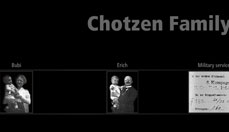Daniel Steinbach and Gorch Pieken, Deutsches Historisches Museum, Berlin / German Historical Museum, Berlin
http://www.chotzen.deAbstract
The project Jewish Life in Germany from 1914-2004 is a joint initiative of the Deutsches Historisches Museum, Berlin (German Historical Museum) and the Bundeszentrale für politische Bildung, Bonn/Berlin (Federal Agency for Civic Education). It is an example of how museums can find further audiences at schools and other institutions of education.
The project is based on a multimedia application that documents Jewish life in Germany from the First World War to the present day. It presents, through the personal fate of a German family of Jewish faith, stories of emancipation and integration, persecution and extermination as well as new beginnings and reformation after 1945 and Jewish life in reunified Germany.
The application is reaching users in three linked, but independent ways: a) as an installed computer station in the new permanent exhibition of the German Historical Museum, b) as a Web site http://www.chotzen.de c), and as a DVD that can be obtained from the museum shop and the Federal Agency for Civic Education.
Keywords: DVD, Jewish-German history, Holocaust, media education, schools
Basis, Aims, and Potential of the Application
The application Jewish Life in Germany 1914-2004 is based on a computer station that was set up in 2002 during the special exhibition Holocaust - The National Socialist Genocide and the Motives of its Remembrance' in the German Historical Museum. Visitors appreciated the simple navigation, the plain ascetics, and the rich content. However, the computer station shared the dilemma of many multimedia features in a museum: a limited number of computers and a short presentation period. This problem was especially evident during the school tours that visited this exhibition. Together with the Federal Agency for Civic Education, the museum tried to develop other ways of making the museum's multimedia application accessible. In late 2004, the Web site http://www.chotzen.de was launched, followed by a DVD half a year later. Although the Internet seems to be the easiest way of access, many users (often schools) are technically not well enough equipped to use all the features in the application or have to deal with long loading time. The DVD, whose second edition is planned for this year, provides a cheap and easy to install alternative which has the further advantage that is can be taken home straight from the museum.
Sources and Material of the Application
The main feature of the application is two parallel timelines. One timeline is dedicated to the political and cultural backgrounds of Jewish life in Germany between 1914 and 2004. The second timeline documents the life and fate of the Chotzen Family, a German Jewish family living in Berlin. This partition should not be understood as a division into 'hard facts' and 'emotional fiction', since both timelines refer to each other and both reflect positive and negative dates in Jewish-German history.
The Chotzen Family Chronicle begins in 1914 and ends with the death of Eppi Chotzen, then the last living member of the family, in April 1992. The political events of these times are given a human face by means of these simultaneous timelines: the political dates and facts of the period are reflected on a personal level in the lives of the Chotzen Family - which is comprised of the mother, Elsa, and the father, Josef, as well as their four sons and the later addition of four daughters-in-law.
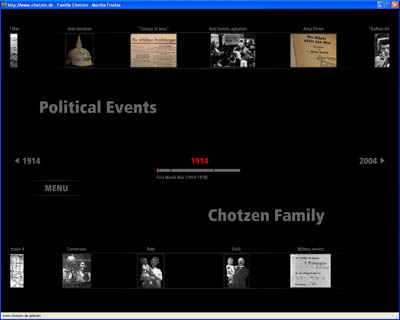
Fig 1: Timeline of the Application
The Chotzen boys were all passionate and proficient photographers, and almost 700 of their black-and-white-photos that were shot before the war have survived in eight photo albums. These photos built the core material to illustrate the events in the family timeline, supplemented through colour pictures and private Super 8 mm films made by Eppi Chotzen.
In addition to these, almost 400 cards and letters that were written by different members of the family after their deportation to the concentration camps in Theresienstadt and Riga survived. These touching documents, which are now part of the collection of the 'Memorial to the House of the Wannsee Conference', are not only used as visual objects, but the most significant lines are also read out to the user.
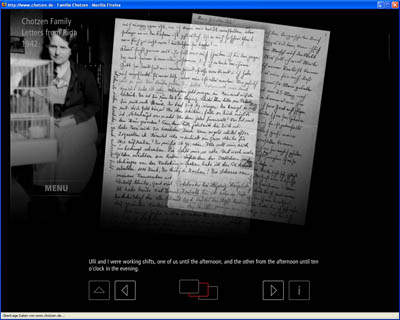
Fig 2: A letter sent from the concentration camp in Riga
A particularly insightful historical document is the large-format housekeeping book kept by Frau Elsa Chotzen between 1937 and 1946. In this book every last detail of the daily incomings and outgoings is recorded. Elsa Chotzen's housekeeping book, now published by the Nicolai Verlag, reflects perfectly the family's daily life across nine years in all of its ups and downs, entry for entry. Some significant pages of this book are shown, together with photos, letters, or specific objects that are mentioned in the entry. Through this, the entries are mirrored in the surviving objects, while the objects themselves are given an additional 'aura' through Elsa Chotzen's housekeeping book.

Fig 3: A page from Elsa Chotzen's housekeeping book
In summer 2003, an interview was filmed with Ruth Weinstein, who was once married to Ulli Chotzen (murdered in 1945) and who is now the only surviving member of the once numerous Chotzen Family. This interview works as a commentary to the events that happened to the family during the Holocaust. Since parts of the interview were filmed in Theresienstadt, the clips carry a strong message.

Fig 4: Ruth Weinstein recalls her memories
The events presented in the political timeline are further illustrated through photos, audio files, and film material. Nearly 1,700 pictures from several German and international collections are used, often presented in collages or in combination with cutout objects. The more than 220 films are excerpts from the German weekly newsreels, evening news programs, and clips from television and cinema movies.
All texts are spoken by a narrator and are simultaneously subtitled for images and videos. In all three mediums, the user can choose between German and English language versions.
Structure and Features of the Timeline
Sorted chronologically, the historical events of the timeline are divided into a multi-layered text system. The layer '0' time strip is always made up of an illustration and a heading. The first layer of information is comprised of one or two sentences of explanation. Those who desire more information have the option to click into the second layer and, where present, the third and fourth layers where quotations or eyewitness reports can be viewed.
A limited amount of text is permitted on the upper layer, which is accessed by most users. The amount of text present in the lower layers, accessed only by users with deeper interests, can be set according to requirements to any length. Emphasis has been given to user-friendliness and ease of understanding the navigation: it is straightforward and easy to learn. The icons listed between the forward and back buttons display the number of layers that can be selected, and the page that is being viewed is highlighted in red.
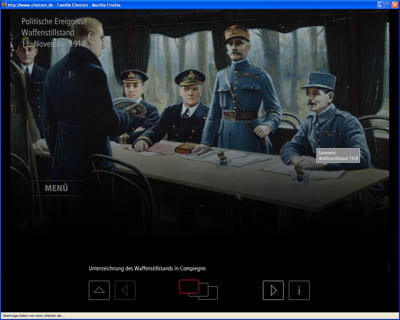
Fig 5: Site structure of an event
The timeline ends - for the time being - in 2004 on the DVD and 2006 on the Web site. The Content Management System makes it possible for further facts and data from future years to be added to the timeline so that the application in the museum and on the Web will stay up to date.
The application also consists of an extensive glossary and one hundred individual biographies that can be referred to as required from every point. Each layer of the application has a mini-overview of glossary entries available to the corresponding page to be viewed. This means that abbreviations or specialized terms (like 'propaganda', 'NSDAP', or 'anti-Semitism') as well as people (like 'Herman Göring', 'Alfred Einstein', or 'Willy Brandt') mentioned in a text can then be viewed in a list in a pop-up and can then be swiftly interpreted.
Of course, it is also possible for users to access all glossary entries or biographies directly from the main menu. The search function enables fast access to all key terms and phrases. In addition, an alphabetically sorted index enables a quick overview.
For users who are not familiar with the history of the Chotzen family, a simple but helpful tool has been created to get to know the large family. Via an info-button a 'family portrait' (a collage of pictures of all family members) can be viewed in which each name is connected to a short biography.

Fig 6: The Chotzen Family
The family chronicle is also illustrated by means of historical maps of Berlin and Germany. On the city map, all the streets and houses related to any family member are marked: places of birth, education, weddings, work, as well as hiding and imprisonment. The state map shows both the towns where the Chotzens went for vacations and school trips and the sites they were deported to and murdered.

Fig 7: Map of Berlin
A user's progress when using the timelines resembles a probing search or voyage of discovery - or, perhaps, even a reminiscent rediscovery of what has already been learned. Searching for information becomes a rewarding and progressive journey through time, generating a relationship between the user and the locations of the collection and historical scenes.
Educational Concept of the Application
Global information networks and new media technology have opened up a new quality of learning and new horizons for school children and students throughout the world. At the same time, this development presents a challenge to museums as learning places outside schools and universities. Through integrating multimedia into their exhibitions in the form of audio and film stations, PDA-directed tours, and often computer stations with a higher or lesser level of interaction, museums have reacted to this development. However, a potential problem is the fact that the rich content of these media units can only be used in the museum itself. Complex historical times, like the Holocaust and its aftermath, require a higher level of guidance than can be offered in most applications. In the educational sector, few examples of cooperation based on links between museums and schools exist. In producing a DVD and a Web site based on the computer station and added educational features and material, the German Historical Museum, in cooperation with the Federal Agency for Civic Education, has attempted to bridge this gap.
The application provides learning modules that are structured for three age groups: primary school pupils (aged 8-12), junior high school students (aged 12-16), and senior high school students (aged 16 and older). The apparently limitless capacity to store and link data supports a pedagogically relevant concentration on the subject and learning content.
Since the timeline contains a large data pool, which provides much detailed information, three guided tours ('time travel') through the time line have been developed. Here the pupils are presented with information matched to their age. While the 'time travel' for primary school children takes only 15 minutes and focuses on the Chotzens as a family (including the canary Peter), the guided tour for the teenagers puts the love story between Ruth and Ulli and their sad ending in the centre. For older students, a guided tour that consists of 5 parts, each 20 minutes long, presents a detailed tour of the Holocaust and the fate of the Chotzen family. Supplemental task lists and task sheets for each of the subject guides are available interactively or as PDF-files for students and teachers.
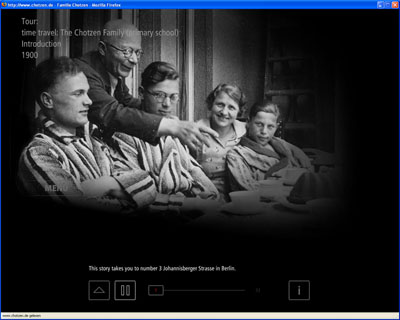
Fig 8: The guided tour for primary school pupils
Further information can be reached via short essays ('text modules') that cover subjects like 'exclusion', 'emigration', 'National Socialism', or 'resistance'. For those not wishing to take advantage of the interactive selection, there are four short films available, each with a maximum duration of three minutes. The subjects they cover include the most important aspects of Jewish life, or those with central points of focus not featured in the timeline; for example, subjects such as 'Jewish Life in Germany Before 1914'.
Finally, in the chapter 'contemporary witnesses & objects' selected photos, items and documents are presented with the story that goes with them, like the Chotzen's housekeeping book or the farewell letter from Bubi and Lisa.
School children can still independently research the data pool. With supportive descriptions of the various source genres such as audio, moving image, still image, or documents, it is possible for school children to create their own subject-related material and text collections. The PowerPoint presentations planned for lessons can be assembled from their own written texts, together with objects, documents, images and films from the timeline, to create individual essays or presentations. They can add other digital material and write their own texts in the template form provided.
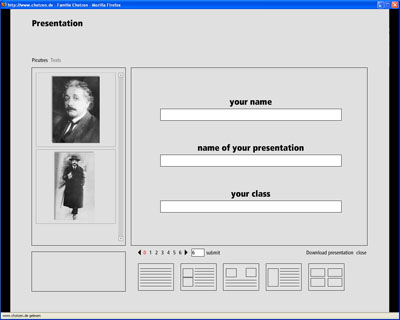
Fig 9: Presentation Template
An important factor is the process for dealing with how the subject matter is structured, the content hierarchy, the presentation of context and the development of a topic focus. This conceptual work demands an intensive comprehension of the subject. The knowledge that each learning success generates goes far beyond the usual receptive forms of learning.
With this project the German Historical Museum hopes to contribute to a better and deeper cooperation between different educational institutions.
Cite as:
Steinbach D. and Pieken G., Jewish Life in Germany 1914-2004: One Multimedia Application - Three Ways of Access, in J. Trant and D. Bearman (eds.). Museums and the Web 2006: Proceedings, Toronto: Archives & Museum Informatics, published March 1, 2006 at http://www.archimuse.com/mw2006/papers/steinbach/steinbach.html
